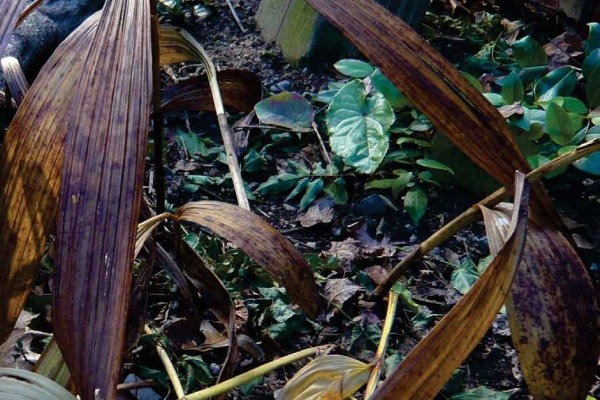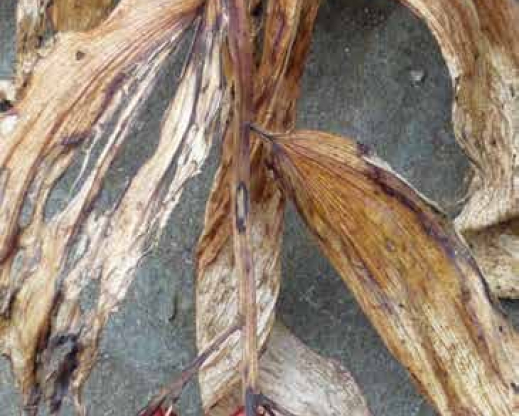As we age, looking into the mirror can be a courageous act, whereas a walk into our autumnal gardens is rejuvenating. This article is a walk amongst some of the species that offer senescent beauty between September and deep winter. There are many more, even in my small Brooklyn garden, than can be given their due in these pages, but I want to give at least some of them a momentary focus.
Starting in early September, the leaves of Maianthemum racemosum, false Solomon's seal, begin turning. The arching grace of its stems, with drying red seeds at their tips is as beautiful as in May. Even the withered remains hold my eye, whether for their structure or the subtlety of color within the dead leaves. Later in the month, the vines turn before other perennials. Codonopsis lanceolata (bonnet bellflower) climbs through a large fothergilla into my neighbor’s very old and towering Kolkwitzia amabilis (beauty bush). While its late summer flowers are lovely yet secretive amidst all the greenery, the foliage is a wonderful chartreuse. In fall it verges into gold and peach before turning white. Another vine, Dioscorea villosa (wild yam), was a seed exchange experiment that has yet to grow to its full height. In its second year it already displays its leaf structure and fall color winningly. If it uses its neighbors as amiably as the Codonopsis I will keep it.
Virginia creeper (Parthenocissus quinquefolia) is hard to miss in eastern North America as its leaves turn red and orange from late August on. Europeans have used it for many years and occasionally in ways that make us reconsider its uses. I refer to the courtyard of Schloss Greinburg on the Danube. The castle, circa 1674, serves primarily as a museum (the Upper Austrian Shipping Museum) and is definitely worth a visit, if only via Wikipedia. The many arches surrounding the large courtyard have been delineated with the vine, both to enhance the architecture and to create a sense of veiled mystery for visitors walking behind the leafy curtains. I chanced on the scene at the height of its senescent beauty. Where can I grow it where it will hang as a curtain and not climb? Or could I create the same effect with the more tender Parthenocissus henryana (silvervein creeper) which sometimes stuns me with its fall color on a neighborhood wall?
Osmunda regalis (royal fern) is another northeastern native, in this case, a focal point of my garden during the summer and fall. It is a very majestic plant: growing against the wood fence, it catches my eye every time I look out the window 50 feet away three floors up. Sometimes it waits until November to start turning, then proceeds slowly through green and yellow, to various shades of copper and finally to a shriveled brown that demands removal. As my fondness for this plant has grown, I make sure it stays moist during the summer.
There are some plants that get my attention in the spring, but slip off the radar until fall. Bletilla striata (Chinese ground orchid) is one of these. And when it regains my attention it has a unique beauty that is now my reason for growing it. The pleated or striped (striate) patternof its long, graceful leaves is highlighted with streaks of brown taffy against the predominant gold. The progression from green to gold, then copper, and finally dark brown, can take a month, during which my attention is at least as steady as during its shorter period of bloom. Even its seed case is an object of beauty, resembling an extremely delicate woodcarving. Usually Polygonatum odoratum 'Variegatum' (variegated Solomon’s seal) provides tints of chartreuse-yellow below the drooping bletilla while an aging wisteria trunk encircles them both, its aerial growth offering the necessary filtered light to plants below.
We must not bypass two elegant, small (12 inches or less) species that could be mistaken, at a glance, for each other. Or they might be taken for ferns because their foliage is bi- or tri-pinnate. But the first, Aruncus aethusifolius (dwarf goat's beard) is in the rose family, while Thalictrum minus (lesser meadow rue) is in the buttercup family. The former is available in better garden centers and has been long-lived for me, delighting me particularly in the fall when its delicate foliage displays several colors at once. The foliage of this plant is its unique feature, not its flowers.
The lesser meadow rue is far from available in garden centers. I grew it from NARGS seed, not knowing any more about it than its short height and it having some tall relatives that I had grown. It was listed as Thalictrum alpinum, but upon consultation, Todd Boland wrote that it was incorrectly labeled. He suggested that it is the lesser meadow rue. It turns out there are various subspecies and varieties, including T. minus var. minus, and my plant’s small size suggests this identification. I believe it has persisted due to the cool, gritty substrate of the chimney flue rock garden right behind it. Last fall it had both deep purple and gold foliage for those who knelt down to observe it. This little rue can’t be bettered for delicacy.
While looking at smaller plants, we might find Sibbaldiopsis (Potentilla) tridentata (three-toothed cinquefoil). It hangs out in cool rock crevices in eastern North America and burns a bright red in the fall. Vaccinium moupinense (Himalayan blueberry), smaller in all its parts than V. corymbosum, is said to be 1 to 2 feet tall and even wider, but hasn’t reached half that size in my garden. It grows in rather lean acid soil and makes up for its petite size with rich colors all year long.
Texture is another quality we should look for in our gardens. In the fall, grasses provide delicate, faded foliage that is a plus amongst the foliage of more brilliant or substantial plants. Carex appalachica shows up above the first snowfall as wheat- colored threads against white. I fell in love with the bigger grasses such as Miscanthus species years ago. But I have dug them out either because of their ever-widening size with a dead zone in the middle, or their slow awakening every spring. (Miscanthus, alive or dead, isn’t fun to remove, and now many forms are considered invasive.)
Obviously, as one who wants lots and lots of plants, I’ve decided that having many smaller plants yields greater pleasure…
The brittle outer husks of Jovibarba heuffelii are wizened and rough, just the opposite texture of Carex appalachica, yet strangely attractive. They surround the green rosettes shrunken with cold. And as spring comes around the strong contrast between dried up outer leaves and interior bright rosette adds to the interest of this type of succulent. Some of the same wrinkled, dark texture is evident on the eastern prickly pear, Opuntia humifusa. The skeletonized pads from previous years may turn black then white while the newer pads, flattened by the cold, are wrinkled green with tints of red. The fruit is like a red headlight asking us for a second look. But beware the minute bristles of this plant! Those on a desiccated pad have lost none of their potential.
If I couldn’t grow at least a handful of epimedium species, I would be the poorer. Some of them have amazing fall color. E. grandiflorum ‘Princess Susan’ is a stand-out. It melts into a caramel, peach, orange medley that other plants can’t duplicate. A maroon E. dolichostemon standing tall and unblemished through most winters is another example of what the genus offers, without the splash of 'Princess Susan'. The
last show-off of this group is E. grandiflorum ‘Purple Prince’ (on the left) whose foliage doesn’t last as long as the other two, but has incredible vigor. Most lovers of epimediums go on about the shape and texture of the leaves or the delicacy of the flowers, but while those are the initial reasons I wanted more selections of this genus, I now hold even dearer the fall colors of some and the winter beauty of others.
Coming to the end of my walk, I would like to draw attention to all these saxifrage family members: Mukdenia rossii, Heuchera americana, Tiarella cordifolia, Micranthes (Saxifraga as was) virginiensis, Bergenia cordifolia and Mitella diphylla for the autumnal interest they add. But for brevity I have chosen the two-leaved miterwort (Mitella diphylla) because its late fall foliage looks so healthy, so persistent, and so intensely maroon. As a bonus, in the spring, the long flowering stems offer unusual blossoms. I would be happy if Micranthes virginiensis, the early saxifrage, would settle down in this garden. It is a charming, native species that was quite content in a low wall I built in the country (Orange County, NY), offering a surprising spot of red foliage during the late fall despite the efforts of its root to pull it back into the wall. But this saxifrage is touchy, and it is rejecting the conditions I offer in Brooklyn. This is an instance where the memory of getting it right elsewhere (and leaving it there) is a consolation when facing a dead plant.
My fall garden is a far cry from the magnificent foliage displayed all over the Northeast, but to even approach that look I would have to grow more iteas, fothergillas, choke berries, enkianthus, viburnum and Japanese maples, not to speak of the large native trees with “eye candy” we know well. I have one each of the iteas, fothergillas, etc. - a few growing in pots, and the rest situated around the garden to give a blast of color above the perennials and bulbs. While I love them,it is the smaller plants that draw me out every day to investigate their emergence in spring, their progress through summer, and their senescence. I need to see the play of larger and smaller shapes, to see a fall-blooming gentian behind the itea, or Iris gracilipes yellowing next to a Heuchera ‘Pinot Noir’. And I believe that we see contrasts of texture more readily when the foliage colors call out to us to get closer. The green on green of summer may not do that or the heat may keep me indoors! So take many walks through your fall gardens, and feel younger and ready for decades more of making plants part of your lives.
We are all indebted to other gardeners for increasing our knowledge, particularly in my case Larry Thomas, the founder of the chapter and a good friend. However, it was a conversation with Thomas Stuart, a fellow member, in which he remarked on "senescent bletilla" that initiated my thoughts for this article. Thank you Tom.


